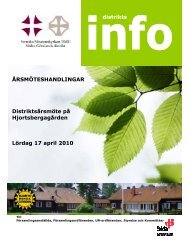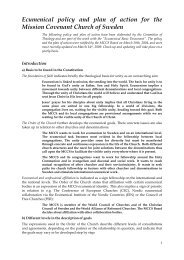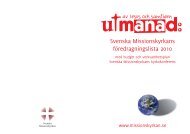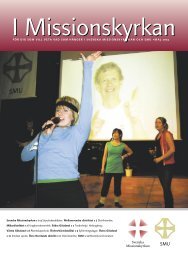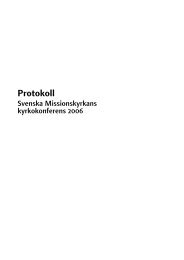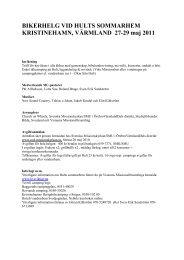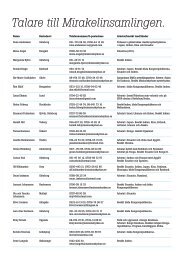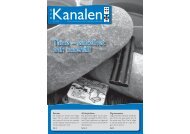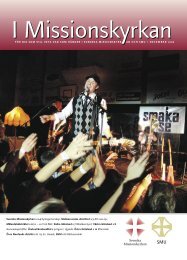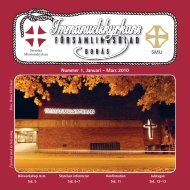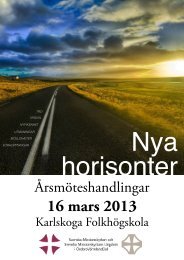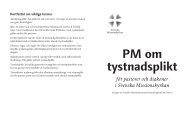Mission and Revolution in Central Asia - Svenska Missionskyrkan
Mission and Revolution in Central Asia - Svenska Missionskyrkan
Mission and Revolution in Central Asia - Svenska Missionskyrkan
You also want an ePaper? Increase the reach of your titles
YUMPU automatically turns print PDFs into web optimized ePapers that Google loves.
Foreword by Ambassador Gunnar Jarr<strong>in</strong>g<br />
The history of Swedish <strong>Mission</strong> covers many years <strong>and</strong> many parts of the world that were<br />
thought to be <strong>in</strong>accessible <strong>and</strong> unreachable. The work <strong>and</strong> liv<strong>in</strong>g conditions of the missionaries<br />
have never been easy. Often the journey to the mission field was full of hardship. Liv<strong>in</strong>g<br />
conditions were very primitive <strong>and</strong> the climate was often tir<strong>in</strong>g <strong>and</strong> bothersome to many.<br />
Illnesses <strong>and</strong> diseases of vary<strong>in</strong>g k<strong>in</strong>ds were a daily experience.<br />
In his historical account of the <strong>Mission</strong>’s history <strong>in</strong> Eastern Turkestan, fulfill<strong>in</strong>g all the criteria<br />
mentioned above, John Hultvall describes <strong>in</strong> detail the work of the Swedish <strong>Mission</strong> <strong>in</strong><br />
<strong>Central</strong> <strong>Asia</strong> which began <strong>in</strong> 1892 <strong>in</strong> the southwest part of the prov<strong>in</strong>ce of X<strong>in</strong>jiang, Ch<strong>in</strong>a’s<br />
most westerly <strong>and</strong> <strong>in</strong>accessible prov<strong>in</strong>ce. The work cont<strong>in</strong>ued until 1938 when the last<br />
missionaries were forced to leave the country because of <strong>in</strong>ternal political turmoil.<br />
John Hultvall’s history of the <strong>Mission</strong> <strong>in</strong> Eastern Turkestan has been written with great <strong>in</strong>sight<br />
on the basis of highly valuable sources with whose help he has been able to present an<br />
<strong>in</strong>tegrated picture of the unforgettable work of the Swedish <strong>Mission</strong> there. It was a difficult<br />
mission field, both physically <strong>and</strong> psychologically. The missionaries were confronted with a<br />
conservative, almost fanatical form of Islam. It would not be true to say that their work<br />
resulted <strong>in</strong> great numbers of people convert<strong>in</strong>g from Islam. Their ma<strong>in</strong> contribution was <strong>in</strong><br />
meet<strong>in</strong>g social needs <strong>in</strong> medical work, <strong>in</strong> education <strong>and</strong> giv<strong>in</strong>g general help. The Swedish<br />
missionaries were not only representatives of Christ but were serv<strong>in</strong>g the people <strong>in</strong> various<br />
ways. Their assistance provided technical help for an undeveloped country. Swedish <strong>Mission</strong><br />
also made similar contributions <strong>in</strong> other parts of the world. In John Hultvall’s book we have a<br />
well documented description of the contribution to <strong>Central</strong> <strong>Asia</strong> by the Swedish <strong>Mission</strong> - a<br />
contribution which was also a cultural one to far away <strong>Central</strong> <strong>Asia</strong>.<br />
. Gunnar Jarr<strong>in</strong>g<br />
Stockholm, September 1980



